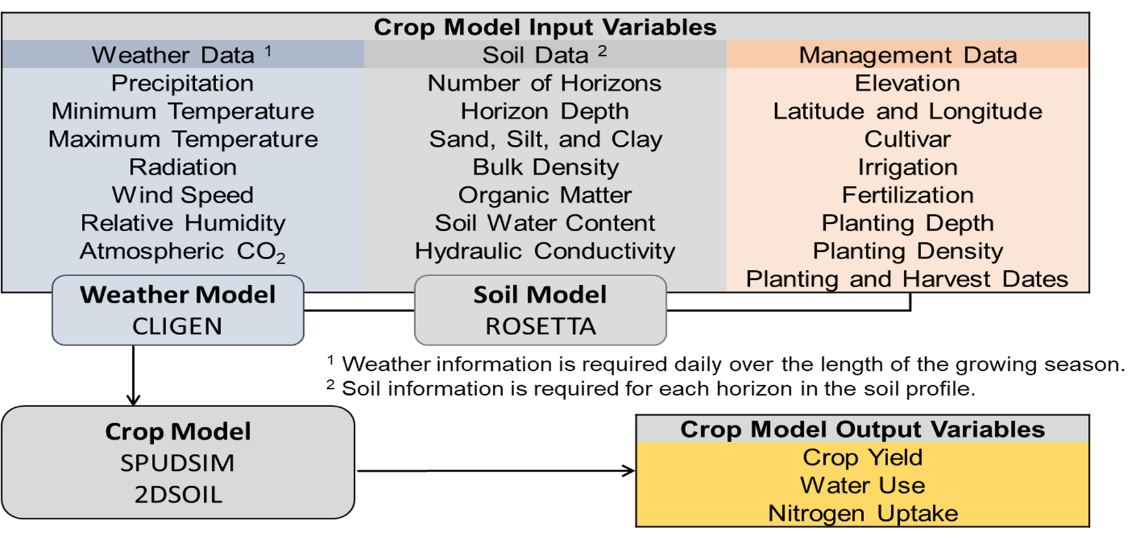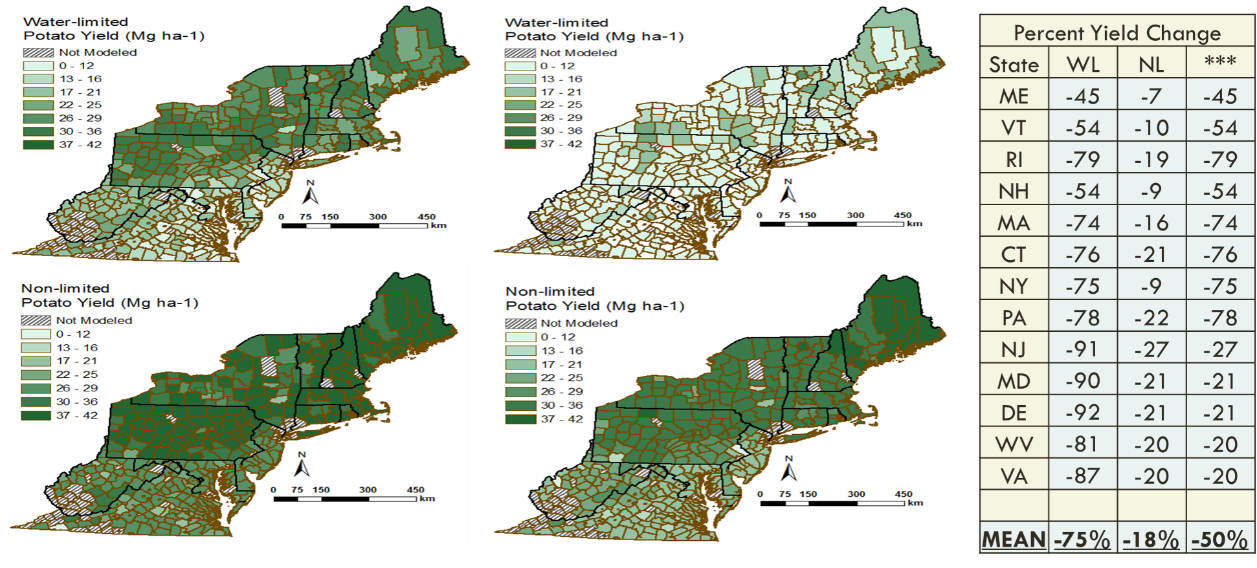| Spudsim (Potato) Model |

|
SPUDSIM is a mechanistic, process level crop model that simulates growth and development of potato from emergence through maturity. The model is integrated with 2DSoil to improve depiction of soil – plant -atmospheric interactions for single or multiple year assessments. It is well suited to provided decision support associated with genetic x environment x management (GEM) components. SPUDSIM runs on an hourly time-step and includes modules for:
• Gas exchange (photosynthesis and transpiration)
• Energy balance at the leaf surface
• Water (W), nitrogen, temperature (T), and carbon stress
• Interactions of CO2, T and W
• Nonlinear effects of T and photoperiod on phenology
• Phenotypic differences
Inputs
Inputs used to drive the model include:
• Management (fertilization, irrigation, row-spacing, plant density, cultivar selection, and etc.)
• Climate (solar radiation, air temperature, relative humidity, wind, rainfall, CO2)
• Soil (texture, bulk density, organic matter, and other physical and hydraulic characteristics)
• Genetics (phenotype responses to environment and nutrient stresses)
Outputs
There are dozens of outputs generated by the model describing dynamic changes in both plant and soil throughout the growing season. The most common ones include:
• Plant leaf area index and dry mass (tuber yield, leaf, stem, root, senesced leaf)
• Seasonal water and nitrogen use
• Photosynthesis, respiration, transpiration, evaporation
Other outputs describe soil status (N, W, root carbon, and other information) and plant physiological indicators such as leaf water potential and stomatal conductance.

Inputs and outputs in SPUDSIM for use in geospatial assessments
Applications
SPUDSIM has been used in multiple applications ranging from geospatial food security assessments, nitrogen leaching in the Pacific Northwest, international model intercomparison studies, and cultivar evaluation in response to climate change.

Projected county-level tuber yields under current (left column) and future (right column) potato production in the U.S. eastern seaboard region under rainfed (top row) or irrigated (bottom row) conditions. Table shows yield changes for non-adapted production in 2050.
References
- Fleisher D.H., Condori B., Barreda C., Berguijs H., Bindi M., Boote K., Craigon J., Evert F.v., Fangmeier A., Ferrise R., Gayler S., Hoogenboom G., Merante P., Nendel C., Ninanya J., Pleijel H., Raes D., Ramírez D.A., Raymundo R., Reidsma P., Silva J.V., Stöckle C.O., Supit I., Stella T., Vandermeiren K., van Oort P., Vanuytrecht E., Vorne V., Wolf J. (2021) Yield Response of an Ensemble of Potato Crop Models to Elevated CO2 in Continental Europe. European Journal of Agronomy 126 https://doi.org/10.1016/j.eja.2021.126265
- Fleisher D.H., Haynes K.G., Timlin D.J. (2020) Cultivar Coefficient Stability and Effects on Yield Projections in the SPUDSIM Model. Agronomy Journal:1-16 https://doi.org/10.1002/agj2.20070
- Fleisher D.H., Condori B., Quiroz R., Alva A., Asseng S., Barreda C., Bindi M., Boote K.J., Ferrise R., Franke A.C., Govindakrishnan P.M., Harahagazwe D., Hoogenboom G., Naresh Kumar S., Merante P., Nendel C., Olesen J.E., Parker P.S., Raes D., Raymundo R., Ruane A.C., Stockle C., Supit I., Vanuytrecht E., Wolf J., Woli P. (2017) A potato model intercomparison across varying climates and productivity levels. Glob Chang Biol 23:1258-1281 https://doi.org/10.1111/gcb.13411
- Resop J.P., Fleisher D.H., Timlin D.J., Mutiibwa D., Reddy V.R. (2016) Climate, Water Management, and Land Use: Estimating Potential Potato and Corn Production in the U.S. Northeastern Seaboard Region. Transactions of the ASABE 59:1539-1553 https://doi.org/10.13031/trans.59.11748
- Fleisher D.H., Dathe A., Timlin D.J., Reddy V.R. (2015) Improving potato drought simulations: Assessing water stress factors using a coupled model. Agricultural and Forest Meteorology 200:144-155 https://doi.org/10.1016/j.agrformet.2014.09.018
- Resop J.P., Fleisher D.H., Timlin D.J., Reddy V.R. (2014) Biophysical Constraints to Potential Production Capacity of Potato across the U.S. Eastern Seaboard Region. Agronomy Journal 106:43 https://doi.org/10.2134/agronj2013.0277
- Fleisher D.H., Timlin D.J., Yang Y., Reddy V.R. (2010) Simulation of potato gas exchange rates using SPUDSIM. Agricultural and Forest Meteorology 150:432-442 https://doi.org/10.1016/j.agrformet.2010.01.005
- Fleisher D.H., Timlin D. (2006) Modeling expansion of individual leaves in the potato canopy. Agricultural and Forest Meteorology 139:84-93 https://doi.org/10.1016/j.agrformet.2006.06.002
- Fleisher D.H., Shillito R.M., Timlin D.J., Kim S.-H., Reddy V.R. (2006) Approaches to Modeling Potato Leaf Appearance Rate. Agronomy Journal 98:522 https://doi.org/10.2134/agronj2005.0136
